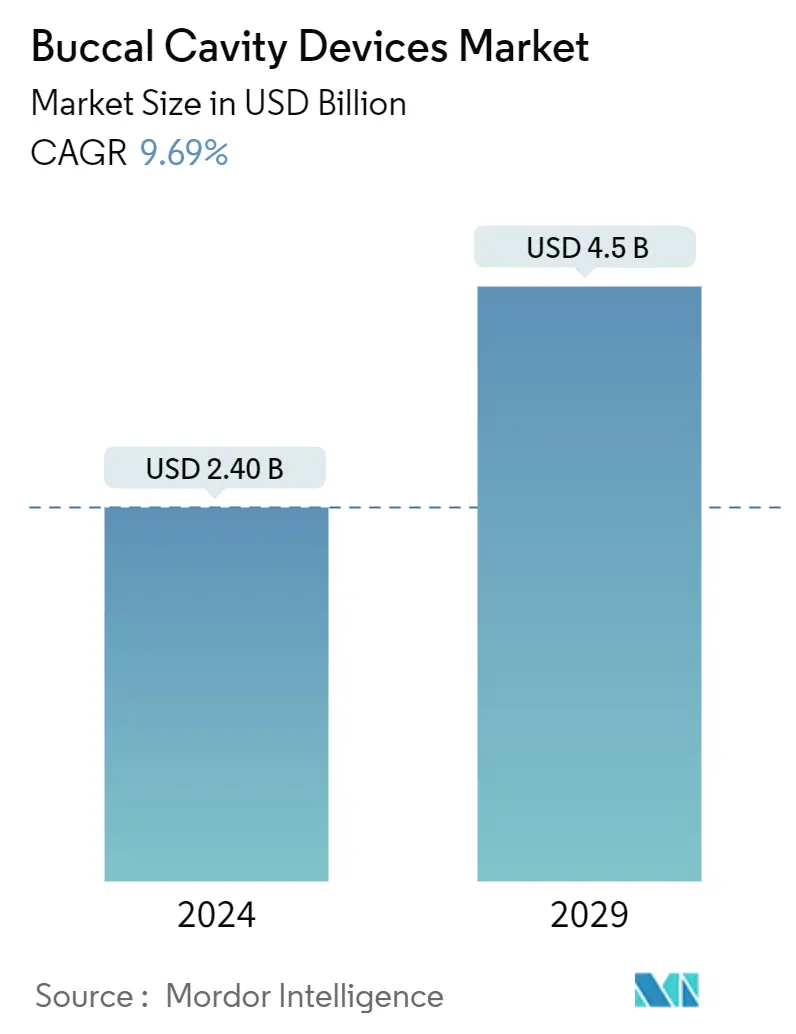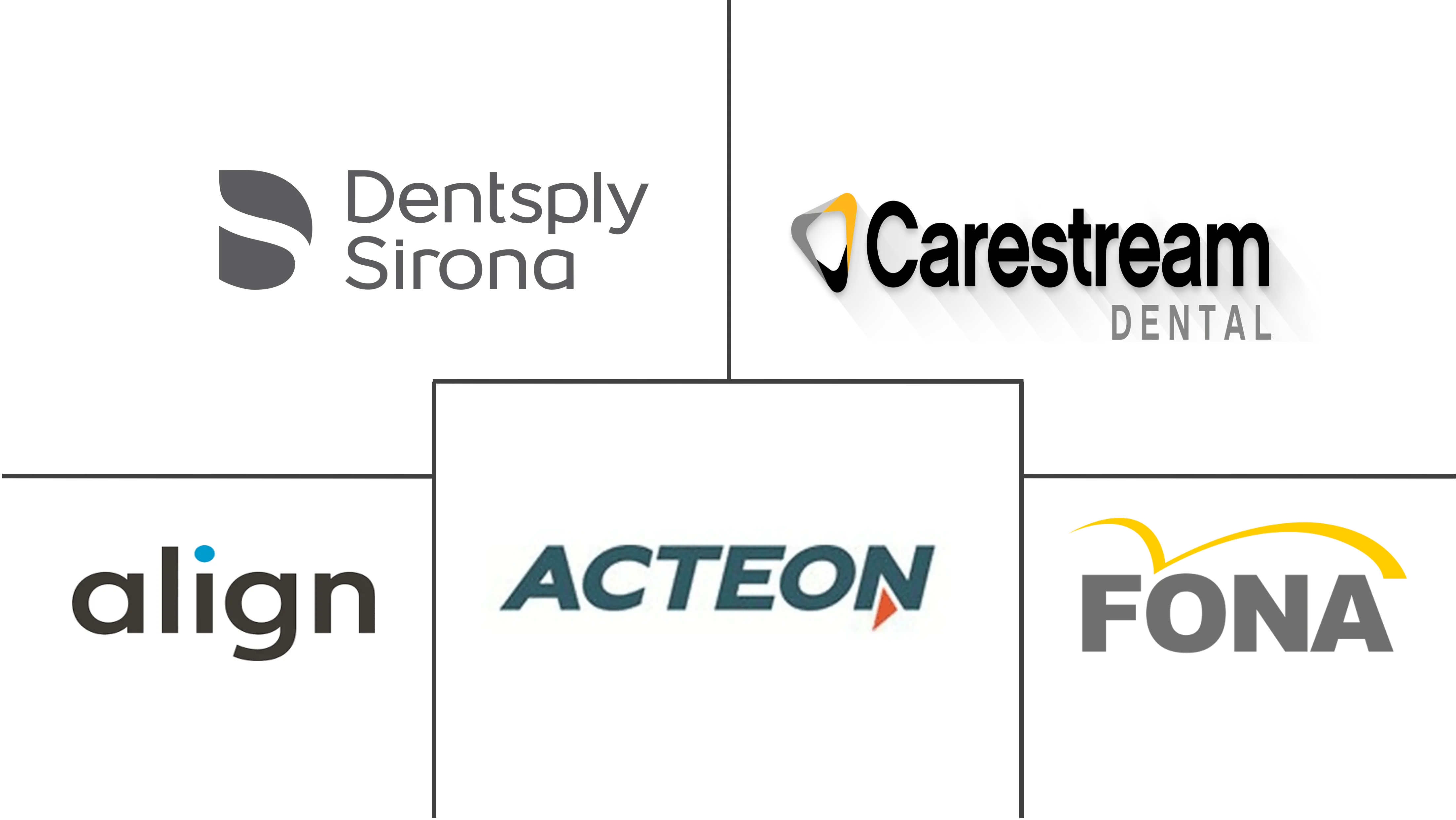Market Size of Buccal Cavity Devices Industry

| Study Period | 2019 - 2029 |
| Market Size (2024) | USD 2.40 Billion |
| Market Size (2029) | USD 4.5 Billion |
| CAGR (2024 - 2029) | 9.69 % |
| Fastest Growing Market | Asia Pacific |
| Largest Market | North America |
| Market Concentration | Medium |
Major Players
*Disclaimer: Major Players sorted in no particular order |
Buccal Cavity Devices Market Analysis
The Buccal Cavity Devices Market size is estimated at USD 2.40 billion in 2024, and is expected to reach USD 4.5 billion by 2029, growing at a CAGR of 9.69% during the forecast period (2024-2029).
The outbreak of the COVID-19 pandemic impacted the studied market significantly. With the strike of COVID-19 and lockdowns all over the globe and fear of co-infections during the initial days, the demand for dental procedures decreased. Additionally, the hospital visits associated with dental treatments and other dental surgeries decreased during the pandemic initially and hampered the adoption of oral or buccal cavity procedures, which adversely impacted the market studied.
However, there has been increased awareness about oral health and maintaining healthy teeth during the later phases of the pandemic, which balanced the loss incurred by the market. For instance, the significance of dental health has been emphasized by the German Society of Dentistry and Oral Medicine (DGZMK), and the systemic relevance of dentistry, especially during the pandemic, published their survey result in December 2021.
As per their survey, 39.1% of all participating doctors saw less than 600 patients per quarter, while 59.9% saw more than 600 patients. This shows a balance between oral care procedures during the pandemic, and considerably balanced the adoption of buccal cavity devices, driving the overall studied market. This is further anticipated to contribute to the overall market studied during the forecast period.
The studied market growth is largely attributed to factors such as the increase in the prevalence of dental disorders, advancements in research and developments (R&D) in dentistry coupled with a rise in disposable income, and are expected to drive the studied market growth during the analysis period.
The practice of keeping one's mouth (known as the buccal cavity) clean and disease-free following several tips is known as oral hygiene. It involves visiting the dentist regularly for dental X-rays, exams, and cleanings. With the high burden of oral diseases across countries worldwide, the demand for buccal cavity treatment is increasing, which is further creating demand for buccal cavity devices.
For instance, as per World Health Organization (WHO) data updated in May 2023, even if oral diseases are preventable with treatment and care, nearly 3,500 million people are affected by oral diseases.
Additionally, as per the data published by the United Health Foundation in 2021, the prevalence of full-mouth teeth extractions due to tooth decay or gum disease among older adults is higher in females than males and those with an annual household income of less than USD 25,000 in the United States.
In addition, as per the above source, the prevalence of oral diseases is more than 7 times higher than those with a household income of USD 75,000 or more annually, and the prevalence decreases with each increase in income level. Therefore, the burden of diseases among poor and aging populations is predicted to have a positive impact on buccal cavity treatment and is anticipated to fuel demand for buccal cavity devices and accelerate market expansion over the course of the projected period and beyond.
However, the high cost associated with intra-oral flat panel sensor products is one of the major factors that is predicted to hamper the market's growth.
Buccal Cavity Devices Industry Segmentation
The buccal cavity is involved in processes such as chewing and swallowing (i.e., mechanical digestion). The buccal cavity has comparatively lower enzymatic activity compared to the gastrointestinal tract, and there are many devices used for the treatment of buccal cavities, including cameras, scanners, and X-ray tubing, which can be used intraoral for disease diagnosis.
The buccal cavity devices market is segmented by product (intraoral cameras, intraoral scanners, and intraoral x-ray units), application (diagnostics and therapeutics), end-users (hospitals and dental clinics), and geography (North America, Europe, Asia-Pacific, Middle East and Africa, and South America). The market report also covers the estimated market sizes and trends for 17 different countries across major regions globally.
The report offers the value (in USD) for the above segments.
| By Product | |
| Intraoral Cameras | |
| Intraoral Scanners | |
| Intraoral X-ray Units |
| By Application | |
| Diagnostics | |
| Therapeutics |
| By End-Users | |
| Hospitals | |
| Dental Clinics |
| Geography | ||||||||
| ||||||||
| ||||||||
| ||||||||
| ||||||||
|
Buccal Cavity Devices Market Size Summary
The buccal cavity devices market is poised for significant growth over the forecast period, driven by increasing awareness of oral health and advancements in dental research and development. The market experienced a temporary setback due to the COVID-19 pandemic, which initially reduced the demand for dental procedures and hospital visits. However, the later phases of the pandemic saw a resurgence in interest towards maintaining oral health, which helped to mitigate the losses. The rising prevalence of dental disorders and the growing demand for buccal cavity treatments are expected to propel market expansion. The market is characterized by a competitive landscape with numerous players, including Dentsply Sirona, ACTEON Group Ltd., and Align Technology Inc., who are actively expanding their service offerings to capture a larger market share.
The North American region is anticipated to witness robust growth due to the high prevalence of oral diseases and a well-established healthcare infrastructure. The demand for intraoral scanners is expected to rise, fueled by the increasing need for dental services and the introduction of innovative devices like the i700 wireless intraoral scanner. Despite the high costs associated with some intraoral products, the benefits of improved workflow and enhanced outputs are driving the adoption of standalone devices. The market's growth is further supported by the rising disposable income and the focus on developing advanced dental solutions, which are expected to create new opportunities for buccal cavity devices in the coming years.
Buccal Cavity Devices Market Market Size - Table of Contents
-
1. MARKET DYNAMICS
-
1.1 Market Overview
-
1.2 Market Drivers
-
1.2.1 Rise in Prevalence of Dental Disorders
-
1.2.2 Advancements in R&D in Dentistry Coupled with Rise in Disposable Income
-
-
1.3 Market Restraints
-
1.3.1 High Cost Associated with Intra-oral Flat Panel Sensor Products
-
-
1.4 Porter's Five Forces Analysis
-
1.4.1 Threat of New Entrants
-
1.4.2 Bargaining Power of Buyers/Consumers
-
1.4.3 Bargaining Power of Suppliers
-
1.4.4 Threat of Substitute Products
-
1.4.5 Intensity of Competitive Rivalry
-
-
-
2. MARKET SEGMENTATION (Market Size by Value - USD million)
-
2.1 By Product
-
2.1.1 Intraoral Cameras
-
2.1.2 Intraoral Scanners
-
2.1.3 Intraoral X-ray Units
-
-
2.2 By Application
-
2.2.1 Diagnostics
-
2.2.2 Therapeutics
-
-
2.3 By End-Users
-
2.3.1 Hospitals
-
2.3.2 Dental Clinics
-
-
2.4 Geography
-
2.4.1 North America
-
2.4.1.1 United States
-
2.4.1.2 Canada
-
2.4.1.3 Mexico
-
-
2.4.2 Europe
-
2.4.2.1 Germany
-
2.4.2.2 United Kingdom
-
2.4.2.3 France
-
2.4.2.4 Italy
-
2.4.2.5 Spain
-
2.4.2.6 Rest of Europe
-
-
2.4.3 Asia-Pacific
-
2.4.3.1 China
-
2.4.3.2 Japan
-
2.4.3.3 India
-
2.4.3.4 Australia
-
2.4.3.5 South Korea
-
2.4.3.6 Rest of Asia-Pacific
-
-
2.4.4 Middle East and Africa
-
2.4.4.1 GCC
-
2.4.4.2 South Africa
-
2.4.4.3 Rest of Middle East and Africa
-
-
2.4.5 South America
-
2.4.5.1 Brazil
-
2.4.5.2 Argentina
-
2.4.5.3 Rest of South America
-
-
-
Buccal Cavity Devices Market Market Size FAQs
How big is the Buccal Cavity Devices Market?
The Buccal Cavity Devices Market size is expected to reach USD 2.40 billion in 2024 and grow at a CAGR of 9.69% to reach USD 4.5 billion by 2029.
What is the current Buccal Cavity Devices Market size?
In 2024, the Buccal Cavity Devices Market size is expected to reach USD 2.40 billion.

